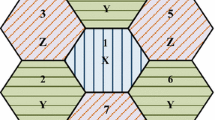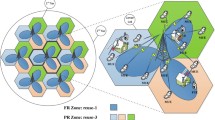Abstract
In cellular communications, one of the main research issues is how to achieve optimum system capacity with limited frequency spectrum. For many years, researchers have proposed and studied many dynamic channel assignment (DCA) schemes to increase the capacity of cellular systems. Another proposed technique, Reuse Partitioning (RP), is used to achieve higher capacity by reducing the overall reuse distance. In convention, when RP is exploited in network-based DCA, a portion of channels will be assigned permanently to each partitioned region. However, the number of channels assigned to each region may not be~optimum due to factors like the uneven and time-varying traffics. In this paper, a new network-based DCA scheme is proposed with the flexible use of RP technique, named as flexible dynamic reuse partitioning with interference information (FDRP-WI). In this scheme, channels are open to all incoming calls and no channel pre-allocation for each region is required. As long as the channel assignment satisfies the co-channel interference constraints, any user from any region can use any channel. The scheme aims to minimize the effect of assigned channels on the availability of channels for use in the interfering cells and to reduce overall reuse distance. Both FDRP-WI with stationary users and mobile users are investigated. Simulation results have confirmed the effectiveness of FDRP-WI scheme. In the case with stationary users, FDRP-WI exhibits outstanding performance in improving the system capacity under both uniform and non-uniform traffic distributions. Under the uniform traffic case, the scheme can provide over 100% capacity improvement as compared to conventional fixed channel assignment scheme with 70 system channels at 1% blocking probability. In the case with mobile users, the impact of mobility on the new call probability, P b, and the call dropping probability, P d, is evaluated. The effect on system capacity of reserving some channels for handoff calls is first studied. Then, we propose a new handoff scheme, called “Reverse Overflow” (RO), to improve the utilization of channels with smaller reuse distances under mobile environment. Simulation results show that, with RO handoff, the system capacity of FDRP-WI is effectively improved at the expense of higher handoff rates in the cellular system.
Similar content being viewed by others
References
Katzela I. and Naghshineh M. Jun. 1996. “Channel Assignment Schemes for Cellular Mobile Telecommunication Systems: A Comprehensive Survey”. IEEE Pers. Commun. 3(3): 10–31
Chong P.H.J. and Leung C. Jul. 2001. “A Network-Based Dynamic Channel Assignment Scheme for TDMA Cellular Systems”. Int. J. Wireless Inform Networks 8(3): 155–165
C.-L. I and P.-H. Chao, “Local Packing – Distributed Dynamic Channel Allocation at Cellular Base Station,” In Proc. IEEE GLOBECOM ’93, pp. 293–301, 1993.
Yeung K. and Yum T. Nov. 1994. “Compact Pattern Based Dynamic Channel Assignment for Cellular Mobile Systems”. IEEE Trans. Veh. Technol. 43(4): 892–896
Chang K., Kim J., Yim C., Kim S. May 1998. “An Efficient Borrowing Channel Assignment Scheme for Cellular Mobile Systems”. IEEE Trans. Veh. Technol. 47(2): 602–608
S.W. Halpern, “Reuse Partitioning in Cellular Systems,” In Proc. IEEE Veh. Technol. Conf., Toronto, Canada, pp. 322–327, May 1983.
Zander J. and Frodigh M. Feb. 1992. “Capacity Allocation and Channel Assignment in Cellular Radio System Using Reuse Partitioning”. Electron. Lett. 28(5): 438–440
Chong P.H.J. and Leung C. Sep. 2001. “Capacity Improvement in Cellular Systems with Reuse Partitioning”. J. Commun. Networks 3(3): 280–287
Chong P.H.J. and Leung C. Jan. 2003. “Performance of Reuse Partitioning in Cellular Systems with Mobile Users”. Int. J. Wireless Inform. Networks 10(1): 17–31
Halonen T., Romero J., Melero J. (2002). GSM, GPRS and EDGE Performance, Evolution Towards 3G/UMTS. John Wiley & Sons, West Sussex
A. Pattavina, S. Quadri, and V. Trecordi, “Reuse Partitioning in Cellular Networks with Dynamic Channel Allocation,” Wireless Networks, pp. 299–309, 1999.
S.L. Chen and P.H.J. Chong, “Capacity Improvement in Cellular Systems with Dynamic Channel Assignment and Reuse Partitioning,” In Proc. IEEE PIMRC ’03, Vol. 2, pp. 1441–1445, Sep. 2003.
D. Hong and S. Rappaport, “Traffic Model and Performance Analysis for Cellular Mobile Radio Telephone Systems with Prioritized and Nonprioritized Handoff Procedures”. IEEE Trans. Veh. Technol. Vol. VT-35, No. 3, pp. 77–92, Aug. 1986.
R. Thomas, H. Gilbert, and G. Mazziotto, “Influence of the Movement of the Mobile Station on the Performance of a Radio Cellular Network,” In Proc. 3rd Nordic Seminar, Copenhagen, Paper 9.4, Sep. 1988.
R. Guerin, “Channel Occupancy Time Distribution in a Cellular Radio System,” IEEE Trans. Veh. Technol., Vol. VT-36, pp. 89–99, Aug. 1987.
Author information
Authors and Affiliations
Corresponding author
Rights and permissions
About this article
Cite this article
Chen, S.L., Chong, P.H.J. & Yang, M. Dynamic Channel Assignment with Flexible Reuse Partitioning in Cellular Systems. Wireless Pers Commun 42, 161–183 (2007). https://doi.org/10.1007/s11277-006-9172-0
Published:
Issue Date:
DOI: https://doi.org/10.1007/s11277-006-9172-0




